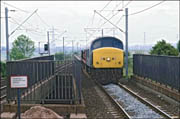 |
At the time I did a bit of photography along the Stour Valley linem between Wolverhampton and Birmingham there wasn't a great deal of freight
to be seen. The majority of what did appear was traffic from and to Wolverhampton Steel terminal and this head-on shot of 45124 on 18 June 1987
shows one of these workings going towards the terminal. It wasn't long before the locomotive returned light engine, later being viewed from the adjacent
canal towpath.
|
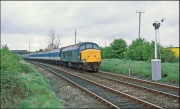 |
Class 45 locomotives were once quite often seen on the North Warwickshire Line while hauling freight trains to and from the South-West and South Wales. Once the line had closed south of Stratford-upon-Avon
they became rarer and were restricted to occasional engineers trains and charters. One of the latter with 45052, is seen here on 2 May 1988 with the Avon Lady tour from London St Pancras to London Marylebone via Leicester,
Nuneaton flyover, Birmingham, Henley-in-Arden, Stratford-upon-Avon (reverse), Hatton, Solihull, Birmingham New Street, Stafford, Rugby, Northampton, Milton Keynes Central, Denbigh Hall South Jn, (via Bletchley flyover), Claydon L&NE Junction, Aylesbury, High Wycombe, Amersham, Harrow-on-the-Hill, and Neasden South Junction.
As it was a Bank Holiday Monday, the light was very poor and I could use a shutter speed of just 1/125 second on 125 asa B & W film. This was the reason for taking the shot by Henley's down outer home signal so early, so as to avoid speed blur as 45052
hauled 1Z37 past me at around the maximum line speed, 60mph.
|
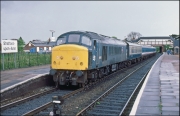 |
Stratford-upon-Avon has always seen occasional charters and railtours and on 2 May 1988 45052 arrived with The Avon Lady from London St Pancras. The poor weather meant that static shots were going to be the best bet
so I took this shot as the train, 1Z37, was waiting for the ground signal to be pulled off so that it could pull out of the station, go beyond the crossover and then be propelled into platform 2 ready for departure.
All this was necessary because no loaded passenger trains were at the time allowed to depart from platform 1 because of the facing points into the down goods loop. The situation in 2025 is very different, with trains
able to arrive at and depart from any of the three platforms.
|
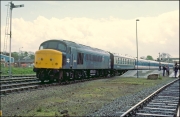 |
Once 45052 had moved into platform 2 on 2 May 1988, I asked the PIC if it would be OK to go off the end of the platform to take a shot of the train. He was quite happy
about this and accompanied me while it took my photograph. The use of Network South East stock was, I think, a first for the terminus and it was a shame that the light
didn't improve enough to really show up the colours but in any event backlighting would have been extreme at this time of day.
|
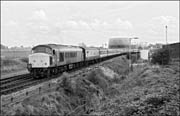 |
The Avon Lady led by 45052 was due to leave Stratford-upon-Avon at 14.30, running to Birmingham New Street via Hatton North Junction and Dorridge. After fiddling aboutm at Stratford
with the shunt moves there wasn't time to get to Hatton for a then very rare shot of a train on the curve between the West and North Junctions ,so I settled for this view from the food canning
factory's land as it accelerated away. Several pieces of infrastructure were familar backdrops to railway photographs taken around here but no trace of them now remains, nor is this spot accessible.
|
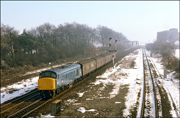 |
I had a day in the Leicester area on 20 February 1986 and once the thick fog had cleared the sun did appear for an hour or so in the afternoon.
This photograph comes from Wigston South Junction and shows 45122 taking 4 vans, probably to the parcel depot near Leicester station, past the remaining semaphores which were due for early replacement.
The new gantry can be seen in the background.
|
 |
The vans in the picture above didn't go far and 45122 soon returned light engine for this view of it passing the signalbox, complete with many white levers, and with the small permanent
way yard in the background. Needless to say, the scene here has changed with the 'box having been removed and with a great deal of track rationalisation having taken place.
|
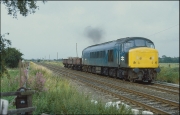 |
This photograph of 45004 with a short train of positively antediluvian-looking wagons was taken from a foot crossing at East Goscote, on the Leicester to Melton Mowbray line. It is hard
to believe that such wagons were still in daily use only 21 years ago, especially with a cargo that appears to be a load of scrap pallets!
|
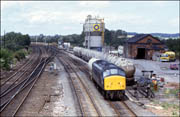 |
Later in the day on 15 August 1985 45004 passed the Blue Circle depot at Syston Junction with a single cement tank of a different type to
those in the siding. This location is, in 2025, the site of Syston station and looks very different in this image from Wikipedia taken from approximately the same spot.
|
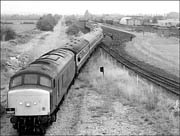 |
I think that this was my first visit to Long Marston to photograph a train. The date was 18 October 1986 and the occasion was HR's Worcester Sorcerer with 37306 and 45144, trailing here, which visited the branch and MOD site as part of the tour's itinerary.
This picture was badly composed to start with and because of the number of photographers on the bridge was tilted to the right and needed a lot of straightening and therefore cropping to correct the verticals, my pet hate being images leaning to the one side or the other.
The train, 1Z26, was topped and tailed and here is the arrival with 37306 leading and after a bit of shunting made for the very unusual sight of classes 37 and 45 double-heading. Needless to say the
weather was dreadful and both black & white and colour films really struggled to produce results that were much good.
|
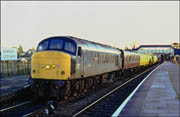 |
The steam-hauled Thames -Avon Express from London Paddington to Stratford-upon-Avon on 14 December 1985 should have been hauled throughout by 4498 Sir Nigel Gresley
but the locomotive failed at Banbury and steam-heat (see at the front of the trailing bogie) 45135 was called up to take the train forward. It was bright and sunny day but unfortunately because of late running
there were a lot of shadows at Stratford station as the Peak prepared to leave platform 1 and enter the Down Goods Loop
to start the process of running round the stock and going into platform 2 for departure. The sun was particularly bright on the chocolate & cream SLOA stock
thanks to a gap between the WW2 cold store amd some trees. To make things worse I had forgotten to reset the exposure meter on my camera to 200asa from 50asa from the previous film and
everything on the slides was horribly overexposed and virtually useless. Four or five shots froma roll of 36 were (sort of) salvageable.
|
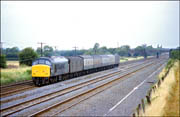 |
Class 45s were the staple motive power for passenger trains on the Midland Main Line for many years but by the date of the picture, 15 August 1985, those workings
had been taken over by HSTs and Peaks were found only on freight and parcels traffic. This is 45118 with an unknown working
passing Cossington with a row of old-fashioned telegraph poles and wires along the lineside. The locomotive is trhe sole member of class 45 to be certified for main line use
and here is a picture of it at Stoke Prior on its first run on 27 July 2024.
|
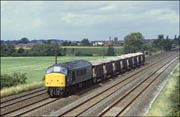 |
A few minutes after I took the picture of 45118 at Cossington shown above the sun came out at the very last second as 45140 passed with a heavy ballast train from Mountsorrel Quarry.
|
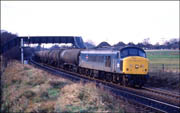 |
If anything other than a class 45 had been hauling this northbound oil train through Water Orton on 11 January 1985 I very much doubt, given the dreadful light, that I would have have
a colour shot. I'm not sure of the train's origin or destination but my notebook suggests that it may be have a STP working from the Albion oil depot
on the Birmingham to Wolverhampton line. The locomotive is 45128 with the unofficial name Centaur on the bodysides.645
|
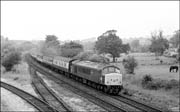 |
Another picture of 45128 but this time with a diverted inter-regional train passing Hatton on on 11 June 1988 - right at the end of its working life. I initally thought that this was a charter
as class 45s were not common on the GWR north of Leamington Spa but the first vehicle behind the locomotive suggests otherwise. I had actually come to Hatton to photograph Castle Class 5080
Defiant on its first run in preservation but was equally chuffed to get a shot of the Peak on the same morning. It was good that the horses in the field between the railway and the Grand Union canal are in shot. In 2022
there is unbroken tree growth all along here.
|
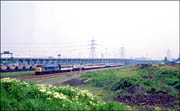 |
This picture was taken on the waste land opposite Washwood Heath yard on 14 May 1998 as 45113 was on the last few miles of its run from Newcastle to Birmingham where
the train would have reversed and probably taken over by a class 47 for the onward journey to Poole. My slide mount noted that this was final such working for class 45 and I guess that
this may be correct because I made a special effort to go and photograph it. Note the sets of HAA MGR wagons waiting for their next trip some time the following week.645
|
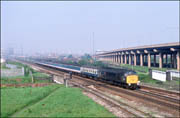 |
A bit further out of Birmingham on the main Derby line is Bromford Bridge where the line crosses the River Tame and this is the location for my shot of 45110 hauling the Pathfinder Peak N Sea railtour on 14 May 1988.
This locomotive worked only from Birmingham New Street to Leicester from where 45052 went forward. The buffers have been cleaned and painted for the trip but the rest of 45110 was still in the usual grubby state of most loocmotives at the time.
|
_wolves_20888) |
Towards the end of class 45 being used on the main line 45106 was painted into green livery with the intention of being BR's flagship locomotive for railtours. Unfortunately, it caught fire after a relatively short period and was replaced with 45128. The latter locomotive
was withdrawn after a few weeks marking the end of these heavyweight locomotives outside preservation. Freshly painted 45106 is here seen running into a dreary and damp Wolverhampton station on its first run with a Pathfinder tour to Scotland on 20 August 1988. 645
|
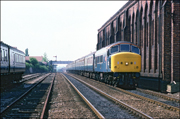 |
On 9 May 1987 a football charter ran from Kidderminster to Wembley and a cleaned-up 45104 was provided to run the train as far as Coventry where a class 85 took over. Here is the empty
stock passing the impressive shed at Kidderminster as it approached the station. At this time there were still sidings extant on the down side with a class 116 DMU in one of them
and the mechanical signalbox just beyond the footbridge was in use.
|
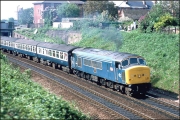 |
A short while later the tarted-up 45104 was pictured leaving Kidderminster on 9 May 1987 with the footex to Wembley for the fans of the local team. I'm not sure how many passengers
were football fans but there did appear to be a healthy number of bashers on board getting some rare Peak haulage for this line.
|
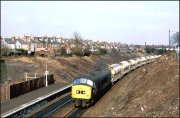 |
This picture shows 45036 about to pass Kidderminster(BR) station on 1 March 1986 with the Saturday morning Cliffe Vale to St Blazey china clay empties. This train was diverted from its
usual route via the Lickey Incline because of major engineering work in the Birmingham area. This image is not of the highest quality but I have included it here because of the train's routing and the loco's split black
headcode panel with white marker spots.
|
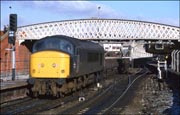 |
In the middle 1980s there was an almost constant flow of freight through Manchester Victoria station and some excellent images could be taken from the remains
of the adjacent Exchange station. Here is 45058 with a short set of mineral wagons passing under the footbrdge at the Eastern end of Exchange on 27 February 1986; a picture taken
by edging a few yards along the paving on the "wrong" side of the car park fencing.
|
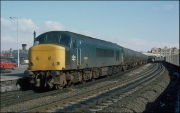 |
The second class 45 image taken on 27 February 1986 involved me in some quite uncharacteristic bravado. 45069 appeared from the east on a long train of oil tankers heading for Weaste - probably 6M16 04.20 from Lindsey. It was stopped at the signal
to pick up a shunter and stood ticking over in the sun, which of course, was on the wrong side of the platform. The land on the right side for the light was a car park which was protected from the railway by a
tall wire-mesh fence. There was however, a very narrow strip of paving on the "wrong" side of the fence and which was just about accessible from the bridge visible in the background. I looked at the long and
slightly dangerous prospect for a few seconds and then decided "what the hell", and set off for the front of the train, all the time expecting either to get gripped or for the new crew to appear and take it away before
I reached the appropriate spot. None of these happened, although I did appear to alarm the driver of a class 47-hauled express on the nearside line, if his gestures were anything to go by. In the event I obtained my photograph,
as you can see.
|
 |
It wasn't just freight traffic seen at Manchester Exchange on 27 February 1986 as this image of 45143 shows. The locomotive was working a Liverpool to York express during the early afternoon
and was slowing for the stop in Victoria station.
|
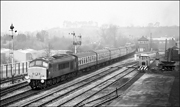 |
Saturday 27 February 1988 was a very dull and misty day with early morning fog being slow to clear. I was lucky to get any sort of picture at Droitwich Spa but did take this view
of 45110 about to pass the station while working Pathfinder Tours The Pembroke Coast Explorer. The Ruston shunter in the sidings ws there to shunt the 2 or 3 wagons of domestic coal
that arrived from time to time. I never managed a shot of the train itself there; just a few shots with this 0-4-0 locomotive and one or two with the hoppers present.
|
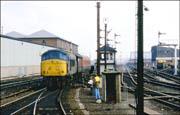 |
In 1986 the Midland Main Line still had large numbers of semaphore signals and was thus well worth a visit. On the 25th April of that year just after I arrived 45029 approached the station from the north
with Test Coach 10 sandwiched between 2 barrier vehicles on an unknown working. Leicester North signalbox is in the centre of the picture with the stabling point, Swain Street Sidings, on the right.
|
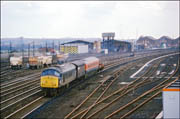 |
Later in the day on 25 April 1986 I was at Wellingborough when 45029 returned north with the same short formation as in the previous picture. The stark contrast between
the Midland Railway sheds in the background and the featureless modern variety is all too obvious is is the portacabin in the right foreground of my picture. I was tempted
to crop this out but left it so as to show more of the older buildings in the background.
|
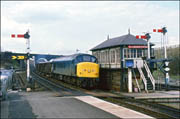 |
After a move from the Finedon Road bridge to the station at Wellingborough on 25 April 1986 I went to the end of the platform to take this shot of 45113 going south with a ballast train which had presumably originated
at Mountsorrel Quarry. Wellingborough Station signalbox was very close to the running lines which must have made this a noisy place to work not to mention the disturbance from vibrations shaking the whole structure with every movement.
|
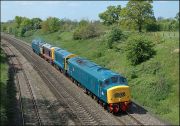 |
Some preserved locomotives were taken from Kidderminster to Ropley on 12 May 2005 for a diesel gala which was also to feature main line certified 45112
so this was the obvious choice to provide the power. The timings were such that I was able to drive from work to Hatton for a shot and chose the 3 arch bridge in Dark Lane
which at the time was sufficiently open for photographs in both direcions. Here is the cavalcade comprising 45112, 20001, 20227 and D1013 descending Hatton Bank
on the way towards Warwick and Leamington Spa.
|
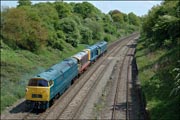 |
Western class diesels were once a common sight on this line so it seemed a good idea to take this image with D1013 Western Ranger as 45113 took it and 2 class 20s from Kidderminster
to Ropley on 12 May 2005. It's not very often that 4 immaculately prepared locomotives can be seen on the main line and it was a treat to have seen them on this bright and sunny day.
|
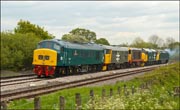 |
The week after the shots of 45112 were taken at Hatton, 45112 returned from Ropley to Kidderminster with 20227 and D1013 but with 37190 and 31108 also hitching a lift. On 17 May 2005
I went again to Hatton Bank but chose a location a few hundred yards south of the road bridge where the sun didn't co-operate. A short video clip of the train
is available via this link.
|
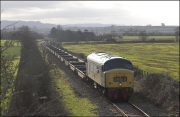 |
I wasn't expecting much activity on Wednesday 31 January 2007, but after returning from my daily swim found a message on my BlackBerry saying that 45112 was working a 4Z47 Chaddesden to Long Marston train conveying more KAA
wagons - these are those that were obtained by Blue Circle cement with a SRA grant to carry lorry cement tanks on a piggyback basis, and which were used for only the initially contracted number of trains from Westbury to Southampton before
being stored at Aberthaw. The tanks also bought with the grant can of course be seen all around Wiltshire on the backs of lorries. Nothing dodgy there then. Anyway, here is 45112 approaching Long Marston with the flats. The sun came out about
half an hour before the train and made life a little difficult, meaning that the lens had to shielded with not only the large "tulip" shade, but by hand as well.
|
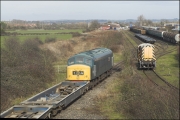 |
The train was originally scheduled to arrive at Long Marston at around 10.45 but in the event didn't leave Worcester until around midday. I went originally to Evesham before knowing the change of times, but whilst there the sun disappeared completely.
Plan B was to go straight to Long Marston where the sun was fine for a 10.45 arrival. Then came the news that there was a long delay. I came home for a drink and went back later, arriving there at about 12.15. Various messages were sent detailing the train's
progress and it arrived at the gate at 13.15 and is here seen going into the complex. I like the idea of the operational headcode panels - wouldn't it be good to have the correct headcode displayed?
|
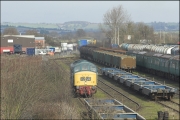 |
The Long Marston shunter, 12088, was soon hooked onto the flats and took them off the exchange sidings in to allow the Peak to exit the site. Here
is 45112 following the train down the sidings prior to leaving. The KAAs visible on the right of 45112 came in here on a previous occasion. The set that arrived today was later coupled
to these and went off for storage.
|
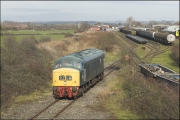 |
Here is the obligatory shot taken as 45112 slowly exits the Long Marston complex. I was sort of surprised to see a Peak here bearing in mind the weight of these locomotives. Class 60s are barred from the branch
but there doesn't appear to have been a problem today. Maybe the additional axles bring the loading within allowed limits.
|
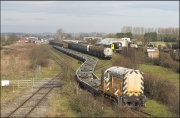 |
Once the Peak had gone off towards Honeybourne followed by most of the gallery, 12082 propelled the KAAs onto the short rake already there. As mentioned above, the two sets of KAAs were coupled together, and here
is that operation in progress. The whole train was still sitting in the exchange when I left but I imagine that it was taken around the circuit before too long.
|
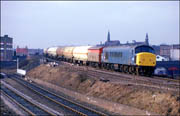 |
There weren't many freights on the Gloucester to Birmingham line on 1984 but one regular runner ws the Hallen Marsh (Avonmouth) to Immingham pressurised
gas tanks. On 21 February 1987 I was at Bordesley Junction when 45052 was photographed descending the Camp Hill Line towards St Andrews Junction with
this train in a short-lived patch of sunshine. The line from Oxford, Leamington Spa and Tyseley is in the foreground and was on here that the few other
photographers present were concentrating as steam locomotive 5593 was due a bit later and after the light had died away completely.
|
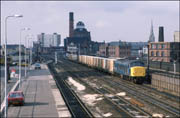 |
Another class 45/0 is seen here, this time passing what remained of Manchester Exchange station on 3 March 1987, with one of the daily household refuse trains
which I think went to Northenden, one of the major receiving terminals where the refuse ended up in landfill. The former station platform at Manchester Exchange
was rapidly becoming a car park by this time although a new fence was later installed to prevent access.
|
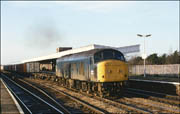 |
This picture was taken at Leamington Spa station on 21 December 1984 and shows 45140 on the up through line with a morning freightliner from Lawley Street to Southampton. This
working was quite often a class 33 turn but on this occasion a none too healthy-looking Peak was in charge. It was a shame that 1) the first flat wasn't loaded and 2) that I hadn't
walked to the other end of the platform when the signal cleared; there was usually plenty of time to do this.
|
 |
Not long after 45140 as shown above had passed Leamington Spa on 21 December 1984 45054 appeared with a short up ballast train cpmplete with 2 brake vans. I think it went only to Banbury as the loco returned light engine about 90 minutes later and went back either Saltley or Bescot.
This pair of pictures were taken on Ektachrome 100aa film which in retrospect wasn't a great choice as the colour dyes seem to have deteriorated over the years.
|
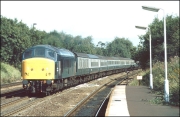 |
Moving onto the main Birmingham to Bristol line, the next photograph shows 45104 on an unidentified down express passing Longbridge on 7 September 1985. There was quite a procession of loco-hauled trains on this line on summer Saturdays and without prior gen or a STN
identification was not always easy.
|
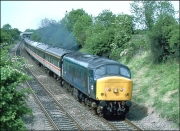 |
In 1986 diesel locos were regularly used to haul the Sunday Luncheon Express from Banbury to Stratford-upon-Avon before a steam locomotive took the train back to London. This reduced coal and water consumption
and made the operation easier for the operating staff. On
8 June 1986 45103 was in use and I photographed it shortly after passing Wilmcote station. I seem to recall that the steam engine allocated to this train failed and this is borne out by the fact that the Peak hauled the
train out of Stratford later in the day. This weekend also saw a regular steam service between Birmingham and Stratford and several photographers can be seen in the left background, where a refuge siding once existed, waiting for the next train.
|
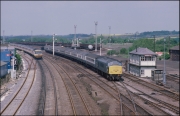 |
This picture is from 4 May 1987 at which time several parts of the Midland Main Line still had semaphore signalling. It shows 45132 passing Finedon Road yard at Wellingborough with an up ECS train as a down HST accelerates away in the opposite direction. The up main line was subject to engineering work north of this point at the time
and trains had to use the up relief as far as Finedon Road, where they crossed to the main line. This gave a much better angle for photography and allowed a wider view of some of the buildings in the yard and the tall, waisted signalbox. About 10 minutes after the Peak had gone south 40122 followed
with a railtour, The Corby Cutler, from Preston to St Pancras.
|
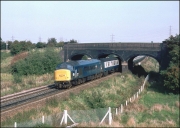 |
Water Orton is north-east of Birmingham and has always been a popular location for railway photography. It can be a frustrating place because trains, particularly freight, can be routed either via the main line or the relief lines via Whitacre Junction. There are
not usually problems with main-line passenger workings as demonstrated by this view of 45140 with a Scarborough to Paignton service about to pass underneath the M42. on 31 July 1987.
|
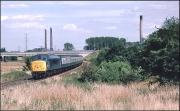 |
On the other side of the M42 some decent shots were possible from the field adjacent to the line. This one shows 45150 with a Newcastle to Poole train on 19 August 1987. The Peak would almost certainly have been replaced by a class 47 at Birmingham New Street.
The long-gone chimneys of Hams Hall power station are visible in the background.
|
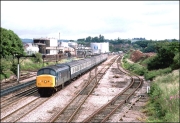 |
The first bridge south of Bromsgrove station is the location for the next picture which shows 45141 with the 07.05 Derby to Paignton on 7 July 1988. The rail-served oil tanks in the background added something to the scene but along with much other railway-related architecture have now gone
and overhead catenary for Cross City passenger trains have changed the whole scene.
|
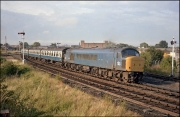 |
A panoramic view of Stratford-upon-Avon station with 45020 and a train of empty coaching stock on 25 July 1984. If passengers had been on board, the train would have been required to shunt into platform 2 and would have left under the control of the tall upper quadrant starter visible to the left
of the lower quandrant inner home signal. This was because of the facing points at the end of platform 1 which on this occasion would have been clipped by the shunter just visible in the background. The details of the working are a little sketchy,
but I think that it was a Henley-in-Arden to York advertised excursion (ADEX) which had run to Stratford so that the locomotive could run round the stock. I was standing on the World War II air-raid shelter which consisted of a large concrete pipe partially buried in the ground and covered with turf and also took a black and white version of the picture. The shelter gave one a useful bit of extra height for a shot of something leaving the terminus in the morning but along with virtually everything else
in the picture it has now gone. The Ministry of Food cold store has been replaced by a Morrison's supermarket and the signalling, now of the 3 aspect electrical variety is controlled from the West Midlands control centre at Saltley.
|
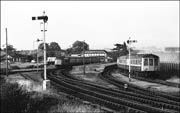 |
Once 45020 had run-round its stock at Stratford-upon-Avon on 25 July 1984 the shunting of a DMU for the the 07.30 to Birmingham Moor Street took place. A couple of sets spent
the night in the cold store siding and were moved as required. In this view shunter and general station factotum Roy Smith is keeping an eye on things and was ready to give the driver in the rear cab a single
buzz on the intercom once the unit had cleared the points so that it could be switched to run into platform 2.
|
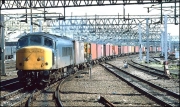 |
This photograph shows 45131 on a northbound freightliner service, the 4D58 1440 Lawley St-Holyhead approaching Stafford station on 14 June 1985. Although this service was regularly
Peak-hauled the use of a 45/1 was more unusual. This view is from the main "down" platform with a 135mm lens which compresses the perspective nicely and shows the mass of overhead catenary.
|
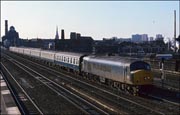 |
Class 45s were, in February 1986 still much employed on class 1 passenger duties and were frequently to be seen on Trans-Pennine expresses. Here is 45128 approaching the stop at Manchester Victoria on 27 February of that year with a Holyhead to Newcastle
service. I loved the industrial backdrop to the scene here and can still almost smell the hoppy aromas from a nearby brewery, some steam from which can seen on the extreme right of the frame.
|
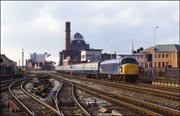 |
Going back a couple of years from the picture above here is another shot of a class 45 passing Manchester Exchange; this time it's 45127 with a Bangor to Newcastle train on 20 October 1984. This picture has much railway interest apart from the loocmotive in that it shows
Deal Street signal box and some early "searchlight" electric signals which have long since been scrapped. This picture isn't as sharp as it might have been because I've had to crop the scan taken from the original slide as a westbound train was close behind me and about to
enter the frame.
|
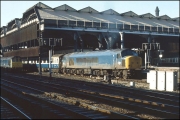 |
Class 45 was yet another of the original main line locomotives to become extinct in the 1980s. They were not as popular as some of the other classes to disappear but I liked them and was always
pleased to get another photograph. The first couple of images were taken, as were the 25s and 40s shown elsewhere on this site, around Manchester Victoria and Exchange stations. Peaks were used on
many passenger and freight workings in this area, particularly on the trans-Pennine services. The first image shows 45136 leaving Manchester for Newcastle on 27 October 1984. Some of the clutter around
the loco is unfortunate, but is more than made up for by the architecture of the old station. Note the station pilot/banker, 25285 waiting for the next job.
|
 |
Defford is still one of many photographers favourite locations on the Brimingham to Bristol line, especially on summer evenings. This photograph shows 45109 on a northbound express just crossing the River Avon. The date was 19 July 1985 and a steam-hauled special had apparently just gone north. I arrived just as the gallery was departing to be told that
I had missed it. I don't think so! Nice light, Bredon Hill and a cricket match in the background...
|
 |
During the summer of 1988 it was possible to see several class 45s around Birmingham. Here is 45121 approaching the footbridge at Water Orton on 1 August 1987 with what my notes say
is the Scarborough to Paignton service. In the background is the long-gone Hams Hall power station which, at this time, was about to be demolished. I took this view against
the sun to include as much of the station's infrastructure as was possible before it disappeared.
|
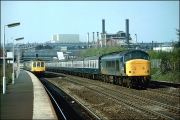 |
Here is a complete corporate blue and grey scene with 45128 running past the vast Rover car complex towards Birmingham with an unknown working. This scene has been transformed by the erection of overhead catenary used by the Birmingham Cross City services from Lichfield to Redditch. The class 116 unit
would now be a class 321 electric unit and the express a Voyager or other unit and, not the least, the complete disappearance of the motor works. This picture was taken on Saturday 11 May 1985.
|
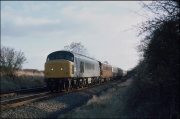 |
There was a private charter to Stratford-upon-Avon on 12 January 1986 called "The Half-Century Limited", from which name I assumed it was to celebrate a 50th birthday. The inward run was behind 4472 Flying Scotsman and 45012 was sent both
to perform the shunt release at the terminus and to return the charter to its starting point. This really was quite unusual, even for 1986, and I was determined to get a shot of the outward working. The sun decided to co-operate and stayed out long enough for me
to obtain this view of the train topping Wilmcote bank. Note the happy punters enjoying a drink on the balcony of the observation car immediately behind the locomotive - they clearly are enjoying the rare traction!
|


























